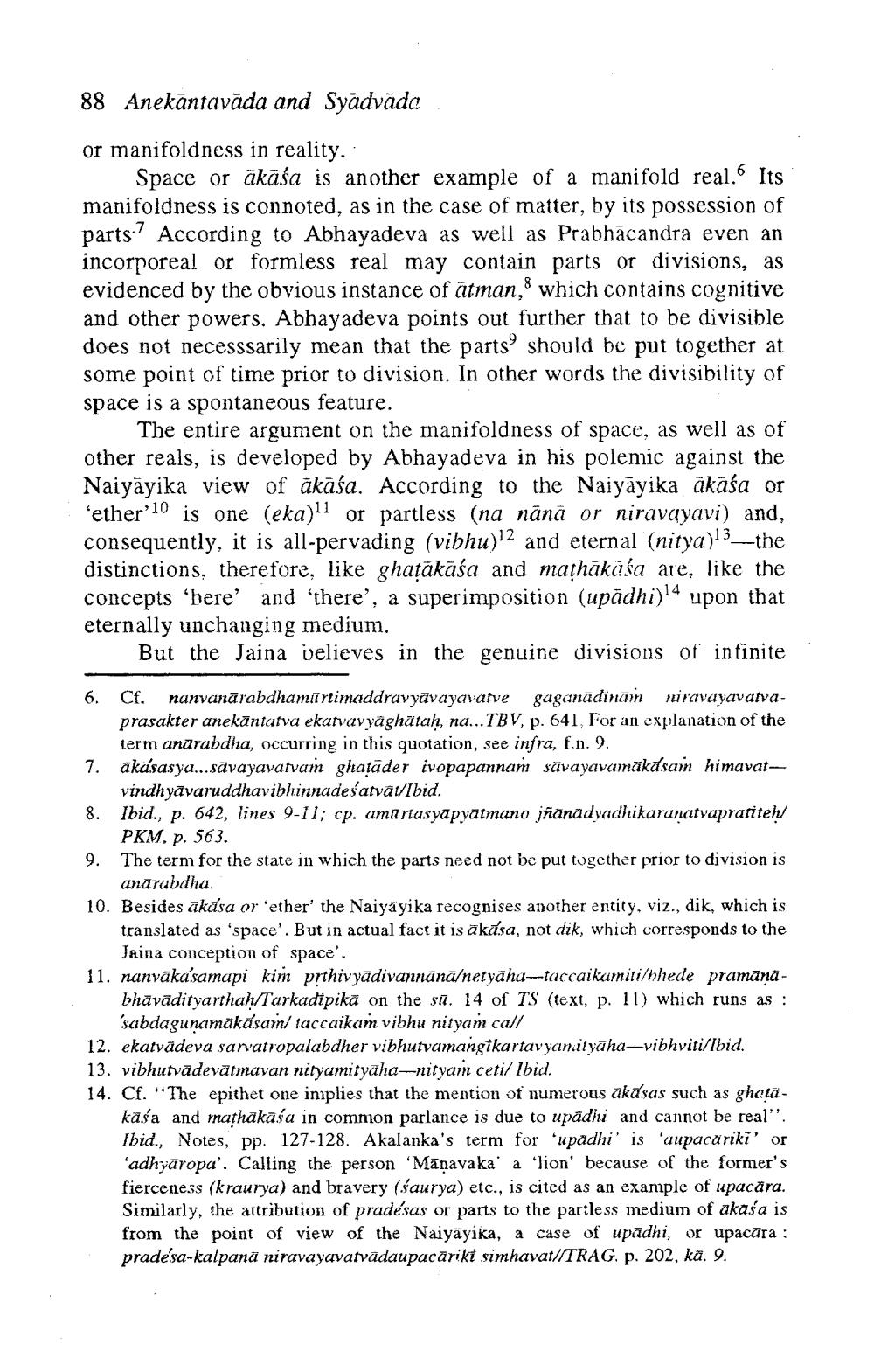________________
88 Anekāntavāda and Syādvāda
or manifoldness in reality.
Space or äkāśa is another example of a manifold real. Its manifoldness is connoted, as in the case of matter, by its possession of parts.7 According to Abhayadeva as well as Prabhācandra even an incorporeal or formless real may contain parts or divisions, as evidenced by the obvious instance of atman, which contains cognitive and other powers. Abhayadeva points out further that to be divisible does not necesssarily mean that the parts should be put together at some point of time prior to division. In other words the divisibility of space is a spontaneous feature.
The entire argument on the manifoldness of space, as well as of other reals, is developed by Abhayadeva in his polemic against the Naiyāyika view of ākāśa. According to the Naiyāyika ākāśa or 'ether10 is one (eka)ll or partless (na nānā or niravayavi) and, consequently, it is all-pervading (vibhu)l2 and eternal (nitya)13--the distinctions, therefore, like ghațākāśa and mathākāśa are, like the concepts 'bere' and 'there', a superimposition (upādhi)l4 upon that eternally unchanging medium.
But the Jaina believes in the genuine divisions of infinite
6. Cf. nanvanārabdhamirtimaddravyāvayavatve gaganādinām niravayavatva
prasakter anekāntatva ekatvavyāghatah, na... TBV, p. 641, For an explanation of the term anarabdha, occurring in this quotation, see infra, f.n. 9. akásasya...sävayavatvam ghatāder ivopapannam sävayavamäkásain himavat
vindhyavaruddhavibhinnades atvat/Ibid. 8. Ibid., p. 642, lines 9-11; cp. amartasyapyatmano jñanadyadhikaranatvapratiteh
PKM. p. 563. The term for the state in which the parts need not be put together prior to division is
anarabdha. 10. Besides akdsa or 'ether the Naiyayika recognises another entity, viz., dik, which is
translated as 'space'. But in actual fact it is akása, not dik, which corresponds to the
Jaina conception of space'. 11. nanvākā samapi kim prthivyādivannānā/netyāha--taccaikamiti/nhede pramana
bhāvādityarthah/Tarkadipikā on the sū. 14 of TS (text, p. 11) which runs as :
'sabdagunamäkäsan taccaikam vibhu nityam call 12. ekatvädeva sarvatropalabdher vibhutvamangikartavyanatyaha-vibhviti/Ibid. 13. vibhutvādevātmavan nityumityaha--nityam cetil Ibid. 14. Cf. "The epithet one inplies that the mention of numerous akūsas such as ghota
kasa and mathakaśa in common parlance is due to upādhi and cannot be real". Ibid., Notes, pp. 127-128. Akalanka's term for 'upadhi' is 'aupacúriki' or 'adhyāropa'. Calling the person 'Māņavaka alion' because of the former's fierceness (kraurya) and bravery (saurya) etc., is cited as an example of upacara. Similarly, the attribution of prade'sas or parts to the partless medium of akaśa is from the point of view of the Naiyāyika, a case of upadhi, or upacara : prade'sa-kalpanā niravayavatvādaupacārikt simhavat//TRAG. p. 202, ka. 9.




